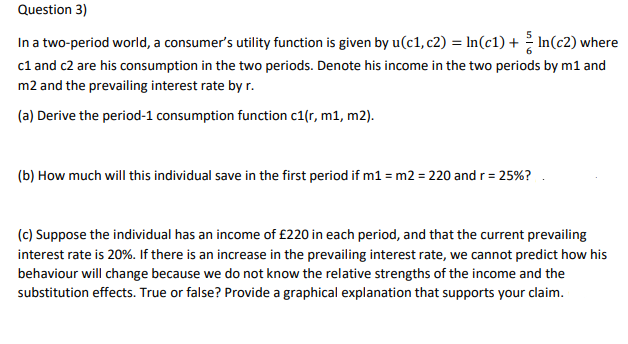Question 3) In a two-period world, a consumer's utility function is given by u(c1, c2) = ln(c1) + In(c2) where c1 and c2 are his consumption in the two periods. Denote his income in the two periods by m1 and m2 and the prevailing interest rate by r. (a) Derive the period-1 consumption function c1(r, m1, m2). (b) How much will this individual save in the first period if m1 = m2 = 220 and r = 25%? (c) Suppose the individual has an income of £220 in each period, and that the current prevailing interest rate is 20%. If there is an increase in the prevailing interest rate, we cannot predict how his behaviour will change because we do not know the relative strengths of the income and the substitution effects. True or false? Provide a graphical explanation that supports your claim.
Question 3) In a two-period world, a consumer's utility function is given by u(c1, c2) = ln(c1) + In(c2) where c1 and c2 are his consumption in the two periods. Denote his income in the two periods by m1 and m2 and the prevailing interest rate by r. (a) Derive the period-1 consumption function c1(r, m1, m2). (b) How much will this individual save in the first period if m1 = m2 = 220 and r = 25%? (c) Suppose the individual has an income of £220 in each period, and that the current prevailing interest rate is 20%. If there is an increase in the prevailing interest rate, we cannot predict how his behaviour will change because we do not know the relative strengths of the income and the substitution effects. True or false? Provide a graphical explanation that supports your claim.
Chapter17: Capital And Time
Section: Chapter Questions
Problem 17.2P
Related questions
Question

Transcribed Image Text:Question 3)
In a two-period world, a consumer's utility function is given by u(c1, c2) = ln(c1) + In(c2) where
c1 and c2 are his consumption in the two periods. Denote his income in the two periods by m1 and
m2 and the prevailing interest rate by r.
(a) Derive the period-1 consumption function c1(r, m1, m2).
(b) How much will this individual save in the first period if m1 = m2 = 220 and r = 25%?
(c) Suppose the individual has an income of £220 in each period, and that the current prevailing
interest rate is 20%. If there is an increase in the prevailing interest rate, we cannot predict how his
behaviour will change because we do not know the relative strengths of the income and the
substitution effects. True or false? Provide a graphical explanation that supports your claim.
Expert Solution
This question has been solved!
Explore an expertly crafted, step-by-step solution for a thorough understanding of key concepts.
This is a popular solution!
Trending now
This is a popular solution!
Step by step
Solved in 5 steps

Knowledge Booster
Learn more about
Need a deep-dive on the concept behind this application? Look no further. Learn more about this topic, economics and related others by exploring similar questions and additional content below.Recommended textbooks for you



